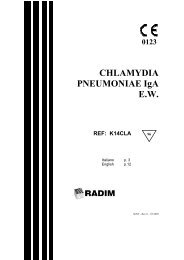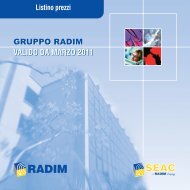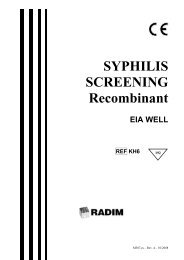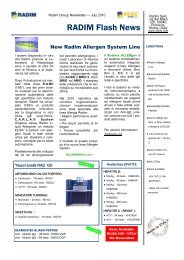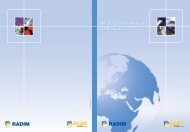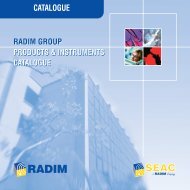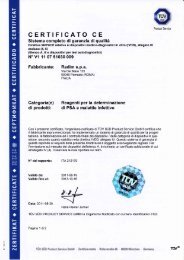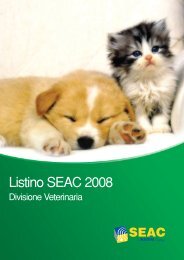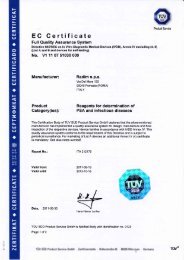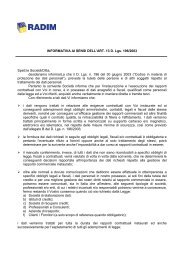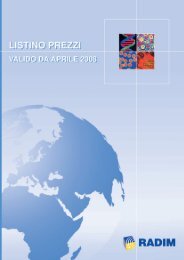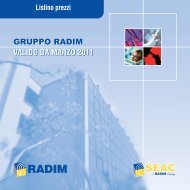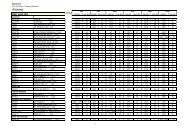ALLERGEN Total IgE REF - Radim S.p.A.
ALLERGEN Total IgE REF - Radim S.p.A.
ALLERGEN Total IgE REF - Radim S.p.A.
Create successful ePaper yourself
Turn your PDF publications into a flip-book with our unique Google optimized e-Paper software.
• Do not smoke, eat or apply cosmetics in areas in which specimens or kit reagents are handled.<br />
• Avoid microbial contamination of reagents during pipetting by using disposable pipette tips.<br />
• Any liquid that has been brought into contact with potentially infectious material has to be<br />
discarded in a container with a disinfectant. Disposal must be performed in accordance with local<br />
legislation.<br />
7.2 TECHNICAL PRECAUTIONS<br />
1. Correct use of reagents and proper pipetting<br />
• The kit has to be strictly employed for the intended use.<br />
• Do not use reagents beyond their expiration dates. Strips and solution should not be used if the<br />
foil bag is damaged or liquids have leaked.<br />
• The TMB/H2O2 single solution is colourless or very slightly blue. On ageing the substrate<br />
becomes slightly yellow-orange but this does NOT affect its performances. If accidental<br />
contamination occurs, the solution starts to develop a blue colour and must therefore be<br />
discarded.<br />
The TMB/H2O2 single solution is not sensitive to light. Direct sunlight can however oxidize the<br />
solution to a blue colour. Such a colour disappears after 4 hours storage in the dark after which<br />
the solution can again be used.<br />
• Use only disposable tips.<br />
• Ensure that no cross-contamination occurs between wells. Keep all pipettes and any other<br />
equipment used for conjugate completely separate from the Substrate HS reagent.<br />
• When pipetting Conjugate or Substrate HS, aliquot for the required numbers of wells should be<br />
taken to avoid multiple entry of pipette tips into the reagent bottles. Never pour unused reagents<br />
back into the original bottles.<br />
2. Adherence to assay procedure and specifications<br />
• The obtained values have to be always compared to the ones reported in QC sheet. Do not use<br />
the kit to determine values outside the range indicated in the IFU.<br />
• The test protocol must be followed strictly. Observe the indicated incubation times and<br />
temperature and the washing procedure, these are critical steps.<br />
• Include the positive and negative controls in every test run to monitor for reagent stability and<br />
correct assay performance. Please refer also to section 10.5 Quality Control.<br />
8.0 SPECIMEN COLLECTION AND STORAGE<br />
• Either serum or plasma can be used with this diagnostic kit. EDTA, heparin and Sodium Citrate<br />
are suitable as anti-coagulants. However, samples to be tested not only for <strong>Total</strong> <strong>IgE</strong> but also for<br />
Specific <strong>IgE</strong> should not contain heparin since this anticoagulant may lead to underestimation of<br />
Specific <strong>IgE</strong> values.<br />
• Whole blood specimens should be separated from red blood cells and plasma or serum as soon<br />
as possible in order to avoid haemolysis. Also clots must be removed.<br />
• Patient samples should be obtained by non-traumatic venipuncture using a vacuum tube or<br />
sterile syringe. The usual precautions in the collection of venipuncture samples should be<br />
observed. If a syringe is used, the blood should be transferred immediately to a vacuum tube<br />
(plain redtop or serum separator).<br />
• Serum and plasma samples can be stored overnight at 2...8°C. For long-term storage, they<br />
should be frozen below -20°C.<br />
• Avoid repetitive freezing and thawing.<br />
A1002 – <strong>ALLERGEN</strong> <strong>Total</strong> <strong>IgE</strong><br />
M541 – Rev. 1 – 06/2010 – Pag. 13/32



